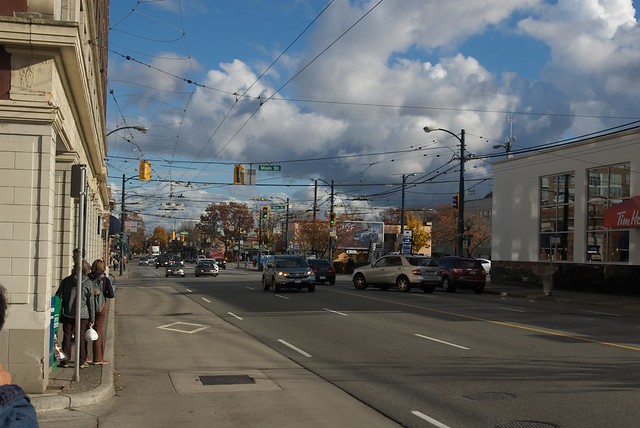Last month City Council adopted the Mount Pleasant Community Plan (MPCP). The MPCP, the culmination of three years of community feedback and consultations, is the first city-sponsored community plan for the area since 1989.
Many residents of Mount Pleasant are concerned about what is happening to their neighbourhood – and with good reason. There have been significant demographic shifts since the last census was performed in 2006. Condos have been popping up along Kingsway, Broadway and Main. Mount Pleasant is a traditionally working-class neighbourhood, the average income in Mount Pleasant being thousand dollars below the citywide average. 23% of people living in the neighborhood are low-income and 67% in the neighborhood are renters.
Mount Pleasant residents have been becoming more active in recent months – many concerned about gentrification and affordability, others concerned about height of new buildings in the abstract.
This summer, these issues came to the surface in a debate about a development at one of the area’s hubs – a social housing and rental development project at Broadway and Fraser. The City Council meeting dealing with the rezoning had to be extended to three days to accommodate the more than 70 speakers. Some members of the community argued that the proposed 11 story development was too tall, where others argued that the neighbourhood is in dire need of more rental and social housing units. In the end, the project was approved with minor adjustments.
The MPCP passes over many of these issues, and attempts to reconcile the wishes of existing residents with developers’ desire for increased density.
Height
Height and density are always related, as pointed out in this recent Mainlander article about the Downtown Eastside Height Review. The community plan doesn’t make very many rigid statements about the future of height in Mount Pleasant. The plan proposes a “high-low massing rhythm,” with modest height as the norm. However, it also “supports the design of ‘iconic’ buildings when granting permission for higher buildings” and proposes “urban design objectives with higher densities in low, medium, and high rise forms of development.” In a sense, this makes room for buildings like the 26 story Rize development, a project that will completely change the nature of the neighbourhood. As of now, there are no high-rises in Mount Pleasant. Whether or not the community plan opens the door for sky-scrapers around Broadway and Main, or along Kingsway, will probably depend on community reaction around “site-specific rezoning” that will take place at City Council on a future date. It’s interesting to note that most of the Community Concerns in the plan are about height. Six stories seems to be what those who were consulted felt comfortable with.
Culture
One of the principles of the plan is to maintain culture in Mount Pleasant. To do this, the city is going to have to balance new developments and the loss of cultural spaces. Condominiums and performance venues mix very poorly. Part of the reason Vancouver is often dubbed a “no-fun city” is the seemingly perpetual loss of venues. Mount Pleasant has a high concentration of musicians and artists, and there are movements to create and maintain cultural spaces.
Little Mountain Studios is a recent example of the clash between homeowners and artists. A space that had once hosted a few nights a week of live music is now struggling to stay afloat because of noise complaints. There is currently a large condo development proposed across the street from one of Mount Pleasant’s largest and most popular music venues, the Biltmore Cabaret. In the past, venues have struggled to survive the noise complaints that come with the arrival of dense developments right next door. The plan doesn’t mention this conflict, and in the past, all the cards in the battle between condos and culture spaces have been held by real-estate developers. It would be nice to see the city pay attention to some of the already existing cultural venues and take this into account when discussing rezoning.
Heritage
Heritage is a touchy subject throughout the city. Often, the use of heritage in rezoning means that a few architectural features of a building are kept, but that the people who had originally used the building are priced out. Woodward’s is an example in which a developer used heritage in a project that ends up with a building used by a different class of people than those who had historically used it. The MPCP proposes “consider[ing] making Mount Pleasant a heritage area”. However, Mount Pleasant has historically been a working class neighbourhood, with an income around $10,000 less that the city average and many more renters than homeowners, as mentioned. If the recent uses of heritage and amenities in the Downtown Eastside are any example, it might not be in the interest of current residents to emphasize the community’s heritage.
Overall, the Community Plan will serve more as a series of guidelines than as an actual plan for development. The emphasis on site-specific rezoning will mean that there will be opportunities for further public engagement. This involvement will be paramount. City Council has in the past been resistant to resident concerns and even completely ignored citizen’s priorities. The Rize development on the south-east corner of Broadway and Kingsway, at 26 stories, has many people concerned about the neighbourhood’s future landscape. The development of that key block is included in the community plan, but the discussion of its height is ambiguous, as though the city knows they won’t be able to get away with a development of that scale. It seems that this project has already attracted more attention than the community plan itself.

